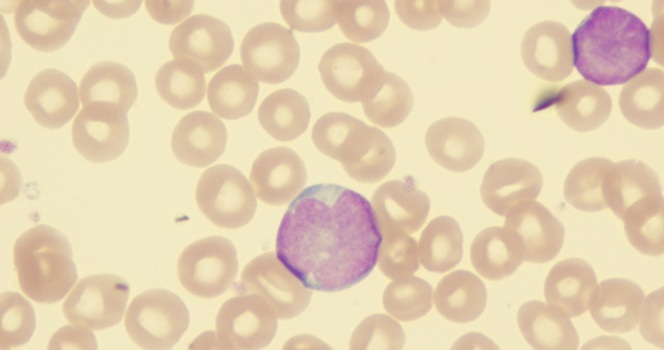Hijacked Commensal Gut Bacteria Promote Intestinal Foodborne Illnesses
|
By LabMedica International staff writers Posted on 24 Dec 2014 |

Image: Colonies of Escherichia coli bacteria grown on a Hektoen enteric agar plate medium (Photo courtesy of the CDC – US Centers of Disease Control and Prevention).
Though many Escherichia coli bacteria are harmless and critical to gut health, some E. coli species are harmful and can be spread through contaminated food and water, causing diarrhea and other intestinal illnesses.
The enteric pathogen enterohemorrhagic E. coli (EHEC) is the cause of severe diarrhea, but the influence of the gut microbiota on EHEC infection is largely unknown and a predominant member of the microbiota, Bacteroides thetaiotaomicron (Bt), is resident at EHEC attachment sites.
Microbiologists at the UT Southwestern Medical Center (Dallas, TX, USA) grew various strains of bacteria anaerobically and extracted ribonucleic acid (RNA) using a RiboPure Bacteria RNA isolation kit (Ambion; Grand Island, NY, USA). E. coli gene arrays were used to compare gene expression in strain EHEC O157:H7 strain 86-24 when cultured alone to that in strain 86-24 when grown in the presence of Bt. Growth curves and generation times were calculated. Quantitative reverse transcription-polymerase chain reaction (qRT-PCR) was performed in a one-step reaction using an ABI 7500 sequence detection system (Applied Biosystems; Foster City, CA, USA). Fluorescein actin staining assays and histopathology were also performed.
The team discovered that EHEC uses a common gut bacterium called B. thetaiotaomicron to worsen EHEC infection. B. thetaiotaomicron is a predominant species in the gut's microbiota, which consists of tens of trillions of microorganisms used to digest food, produce vitamins, and provide a barrier against harmful microorganisms. EHEC senses changes in sugar concentrations brought about by B. thetaiotaomicron and uses this information to turn on virulence genes that help the infection colonize the gut, thwart recognition and killing by the host immune system, and obtain enough nutrients to survive.
Vanessa Sperandio, PhD, Professor of Microbiology and Biochemistry, and senior author of study said, “We are testing the idea that differential gastrointestinal microbiota compositions play an important role in determining why, in an EHEC outbreak, some people only have mild diarrhea, others have bloody diarrhea and some progress to hemolytic uremic syndrome, even though all are infected with the same strain of the pathogen.” The study was published on December 10, 2014, in the journal Cell Host Microbe.
Related Links:
UT Southwestern Medical Center
Ambion
Applied Biosystems
The enteric pathogen enterohemorrhagic E. coli (EHEC) is the cause of severe diarrhea, but the influence of the gut microbiota on EHEC infection is largely unknown and a predominant member of the microbiota, Bacteroides thetaiotaomicron (Bt), is resident at EHEC attachment sites.
Microbiologists at the UT Southwestern Medical Center (Dallas, TX, USA) grew various strains of bacteria anaerobically and extracted ribonucleic acid (RNA) using a RiboPure Bacteria RNA isolation kit (Ambion; Grand Island, NY, USA). E. coli gene arrays were used to compare gene expression in strain EHEC O157:H7 strain 86-24 when cultured alone to that in strain 86-24 when grown in the presence of Bt. Growth curves and generation times were calculated. Quantitative reverse transcription-polymerase chain reaction (qRT-PCR) was performed in a one-step reaction using an ABI 7500 sequence detection system (Applied Biosystems; Foster City, CA, USA). Fluorescein actin staining assays and histopathology were also performed.
The team discovered that EHEC uses a common gut bacterium called B. thetaiotaomicron to worsen EHEC infection. B. thetaiotaomicron is a predominant species in the gut's microbiota, which consists of tens of trillions of microorganisms used to digest food, produce vitamins, and provide a barrier against harmful microorganisms. EHEC senses changes in sugar concentrations brought about by B. thetaiotaomicron and uses this information to turn on virulence genes that help the infection colonize the gut, thwart recognition and killing by the host immune system, and obtain enough nutrients to survive.
Vanessa Sperandio, PhD, Professor of Microbiology and Biochemistry, and senior author of study said, “We are testing the idea that differential gastrointestinal microbiota compositions play an important role in determining why, in an EHEC outbreak, some people only have mild diarrhea, others have bloody diarrhea and some progress to hemolytic uremic syndrome, even though all are infected with the same strain of the pathogen.” The study was published on December 10, 2014, in the journal Cell Host Microbe.
Related Links:
UT Southwestern Medical Center
Ambion
Applied Biosystems
Latest Microbiology News
- Rapid Diagnostic Test Matches Gold Standard for Sepsis Detection
- Rapid POC Tuberculosis Test Provides Results Within 15 Minutes
- Rapid Assay Identifies Bloodstream Infection Pathogens Directly from Patient Samples
- Blood-Based Molecular Signatures to Enable Rapid EPTB Diagnosis
- 15-Minute Blood Test Diagnoses Life-Threatening Infections in Children
- High-Throughput Enteric Panels Detect Multiple GI Bacterial Infections from Single Stool Swab Sample
- Fast Noninvasive Bedside Test Uses Sugar Fingerprint to Detect Fungal Infections
- Rapid Sepsis Diagnostic Device to Enable Personalized Critical Care for ICU Patients
- Microfluidic Platform Assesses Neutrophil Function in Sepsis Patients
- New Diagnostic Method Confirms Sepsis Infections Earlier
- New Markers Could Predict Risk of Severe Chlamydia Infection
- Portable Spectroscopy Rapidly and Noninvasively Detects Bacterial Species in Vaginal Fluid
- CRISPR-Based Saliva Test Detects Tuberculosis Directly from Sputum
- Urine-Based Assay Diagnoses Common Lung Infection in Immunocompromised People
- Saliva Test Detects Implant-Related Microbial Risks
- New Platform Leverages AI and Quantum Computing to Predict Salmonella Antimicrobial Resistance
Channels
Clinical Chemistry
view channel
Chemical Imaging Probe Could Track and Treat Prostate Cancer
Prostate cancer remains a leading cause of illness and death among men, with many patients eventually developing resistance to standard hormone-blocking therapies. These drugs often lose effectiveness... Read more
Mismatch Between Two Common Kidney Function Tests Indicates Serious Health Problems
Creatinine has long been the standard for measuring kidney filtration, while cystatin C — a protein produced by all human cells — has been recommended as a complementary marker because it is influenced... Read moreMolecular Diagnostics
view channel
Simple Urine Test to Revolutionize Bladder Cancer Diagnosis and Treatment
Bladder cancer is one of the most common and deadly urological cancers and is marked by a high rate of recurrence. Diagnosis and follow-up still rely heavily on invasive cystoscopy or urine cytology, which... Read more
Blood Test to Enable Earlier and Simpler Detection of Liver Fibrosis
Persistent liver damage caused by alcohol misuse or viral infections can trigger liver fibrosis, a condition in which healthy tissue is gradually replaced by collagen fibers. Even after successful treatment... Read moreHematology
view channel
Platelet Activity Blood Test in Middle Age Could Identify Early Alzheimer’s Risk
Early detection of Alzheimer’s disease remains one of the biggest unmet needs in neurology, particularly because the biological changes underlying the disorder begin decades before memory symptoms appear.... Read more
Microvesicles Measurement Could Detect Vascular Injury in Sickle Cell Disease Patients
Assessing disease severity in sickle cell disease (SCD) remains challenging, especially when trying to predict hemolysis, vascular injury, and risk of complications such as vaso-occlusive crises.... Read more
ADLM’s New Coagulation Testing Guidance to Improve Care for Patients on Blood Thinners
Direct oral anticoagulants (DOACs) are one of the most common types of blood thinners. Patients take them to prevent a host of complications that could arise from blood clotting, including stroke, deep... Read moreImmunology
view channel
New Test Distinguishes Vaccine-Induced False Positives from Active HIV Infection
Since HIV was identified in 1983, more than 91 million people have contracted the virus, and over 44 million have died from related causes. Today, nearly 40 million individuals worldwide live with HIV-1,... Read more
Gene Signature Test Predicts Response to Key Breast Cancer Treatment
DK4/6 inhibitors paired with hormone therapy have become a cornerstone treatment for advanced HR+/HER2– breast cancer, slowing tumor growth by blocking key proteins that drive cell division.... Read more
Chip Captures Cancer Cells from Blood to Help Select Right Breast Cancer Treatment
Ductal carcinoma in situ (DCIS) accounts for about a quarter of all breast cancer cases and generally carries a good prognosis. This non-invasive form of the disease may or may not become life-threatening.... Read morePathology
view channel
Tunable Cell-Sorting Device Holds Potential for Multiple Biomedical Applications
Isolating rare cancer cells from blood is essential for diagnosing metastasis and guiding treatment decisions, but remains technically challenging. Many existing techniques struggle to balance accuracy,... Read moreAI Tool Outperforms Doctors in Spotting Blood Cell Abnormalities
Diagnosing blood disorders depends on recognizing subtle abnormalities in cell size, shape, and structure, yet this process is slow, subjective, and requires years of expert training. Even specialists... Read moreTechnology
view channel
Artificial Intelligence Model Could Accelerate Rare Disease Diagnosis
Identifying which genetic variants actually cause disease remains one of the biggest challenges in genomic medicine. Each person carries tens of thousands of DNA changes, yet only a few meaningfully alter... Read more
AI Saliva Sensor Enables Early Detection of Head and Neck Cancer
Early detection of head and neck cancer remains difficult because the disease produces few or no symptoms in its earliest stages, and lesions often lie deep within the head or neck, where biopsy or endoscopy... Read moreIndustry
view channel
Abbott Acquires Cancer-Screening Company Exact Sciences
Abbott (Abbott Park, IL, USA) has entered into a definitive agreement to acquire Exact Sciences (Madison, WI, USA), enabling it to enter and lead in fast-growing cancer diagnostics segments.... Read more




 assay.jpg)




 Analyzer.jpg)













